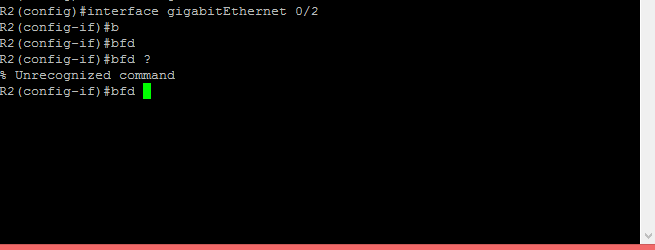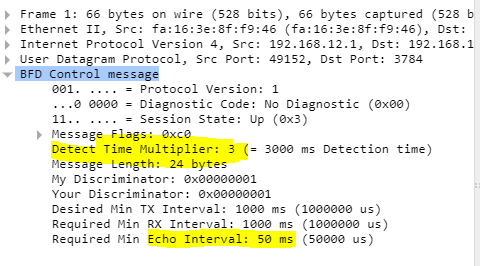Hello Aashish
BFD uses various timers in various modes, and it seems that the names used, and the way they are indicated in the output of this command is not clear.
If you take a look at the config of BFD in the running config you’ll find something like the following:
R1#show run all | incl bfd
bfd slow-timers 1000
bfd l2cos 0
bfd interval 50 min_rx 50 multiplier 3
bfd echo
bfd all-interfaces
If you take a Wireshark capture of a BFD message, like this one, you will see the various timers in there, including the following: Echo interval, and Detect Time Multiplier as shown below:
So with the bfd interval 50 min_rx 50 multiplier 3 command, what you are actually configuring is the Detect Time Multiplier and the Echo Interval. The min_rx value that you configure in the command is not included in the BFD control message simply because it is the amount of time within which a router expects to receive a BFD message from the neighbor, something that is not actually included as information in the captured BFD control message. These configuration parameters have to do with the echo packets, not the control packets.
Conversely, in the output the values of MinTxInt and MinRxInt remain at 1000ms which refers to the slow-timers parameter in the router config.
The holddown timer is actually something completely different than what has been described in the lesson. Rene calls the multiplier the holddown timer (which colloquially speaking is correct), but officially in the RFC the result of applying the multiplier gives you the Detection Time. The holddown timer is something completely different. You can find out more about the holddown timer at Appendix A of RFC 5880.
Yes, this is correct. The slow-timer is set to 1000ms and there have been 617 control packets exchanged.
This is an example of how vendors sometimes use their own terminology to name values and variables that are different from the official RFC, and this can create confusion. For example, the RFC never mentions that BFD uses hello packets. It refers to BFD messages as control packets and echo packets. Cisco calls the MinTxInterval the slow-timers variable… It gets confusing… 
In any case, Rene mentioned that he will rewrite this lesson to more clearly describe the process to avoid confusion in the future.
I hope this has been helpful!
Laz

